INTRODUCTION:
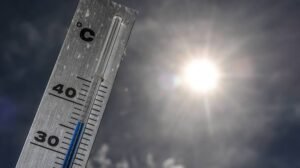
Heat Stroke is one of the life threatening condition in which body temperature rises above 40°C (103°F). It severely alters the cooling system of the body allowing the body to deviate from it’s normal homeostatic mechanisms and can lead to organ damage and eventually death. The risk of heat stroke rises when the environmental temperature goes above 32°C (90°F) and the presence of humidity can increase its risk even more.
WHO ARE AT RISK?
Countries with hot climatic conditions and which are present near the equator are more likely at risk which includes: parts of Africa, the Middle East, Southeast Asia, and Central and South America. Moreover other areas with heatwaves despite their usual climate, are also at risk.
MECHANISM:

Hypothalamus (part of our brain) also known as the main homeostatic organ plays a crucial role in maintaining the body temperature. Prolonged exposure to extreme condtions can lead to its altered activity thereby causing the body to develop hyperthermia (increased core temperature). This allows the enzymes to denature, which carry out the normal metabolic functions of our body. On the other hand, high temperature causes cell and tissue damage, which leads to inflammation, oxidative stress, and eventually cell death.
SIGNS AND SYMPTOMS:

How to know that someone has developed heat stroke? Following are the signs and symptoms that allow you to detect this condition.
▪︎Nausea
▪︎Throbbing headache
▪︎Hot, dry skin( absence of sweating)
▪︎ Confusion
▪︎ Dizziness
▪︎ Loss of consciousness
▪︎ Seizures (in severe cases)
WHY IS IT DANGEROUS?
After damage to our body’s cooling system, the temperature in our body rises significantly altering the normal metabolic function of our body followed by subsequent organ damage, neurological dysfunction, coma or even death if not treated promptly.
WHAT FACTORS CAUSE HEAT STROKE?

Other factors which influences this condition include:
▪︎ Humidity
▪︎ Dehydration
▪︎ Physical Exertion
▪︎ Age (Infants, Children and Old age people are at risk.
▪︎ Health Conditions (like Obesity, Diabetes and Heart Diseases).
▪︎ Medications ( Diuretics, Beta Blockers and Anti-Psychotics)
▪︎ Clothing
▪︎ Alcohol and Drug Use
ENVIRONMENTAL EFFECT ON HEAT STROKE:
Environment has a significant effect in developing heat stroke. Increased damage to earth by mankind has lead to environmental degradation and climatic changes. Following are the factors that are leading drastically towards climatic change.
OZONE LAYER DEPLETION:
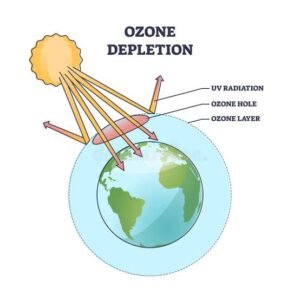
Due to damage of ozone layer the Ultraviolet Radiations reach the surface of the earth directly leading to increased temperature and intense heat-waves.
DEFORESTATION:

Trees and vegetation provide shade and regulate temperature through evapotranspiration. Due to increased deforestation by mankind, this natural cooling mechanism is severly altered which can lead to heat stroke.
GREEN HOUSE EFFECT:
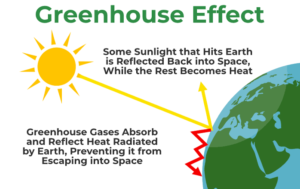
Due to increased pollution by mankind, Green House Gases like Carbon dioxide and methane have accumulated which are making the environment even warmer.
GLOBAL WARMING:

Global Warming due to human activities increases the intensity of heat waves, leading to increased risk of heat stroke.
PREVENTION:
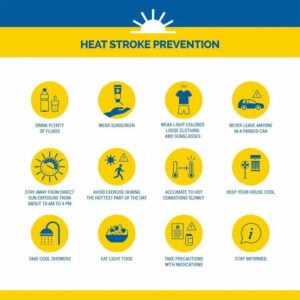
- As heat stroke is a very serious condition it is necessary to take some protective measures to reduce it’s risk.
Here are some preventive tips that you can use to protect yourselves:
- STAY HYDRATED:
Drink plenty of water, eat watery summer friendly fruits like watermelon, melon, berries etc. Make some fruit infused water and sip on it throughout the day.
- PROTECTIVE CLOTHING:
Wear light weight, light colored and summer friendly clothing, that allows air circulation.
- STAY INDOOR:
Try to stay indoor when temperature is high and humidity is also present. Keep an eye on weather forecast and plan your schedule accordingly.
- PRO TIP:
Even if you have to step outdoor on a hot sunny day make sure to use a transport that is Air conditioned or take wet towel with you and keep it around your neck and head.
- TAKE BREAK:
Take short breaks in between exercising or working to allow your body to cool down.
- USE SUNSCREEN:
Apply sunscreen on a daily basis or whenever you step out as it protects you from direct UV rays.
- BE MINDULL OF MEDICATIONS:
Some medications as mentioned above can alter the cooling system of your body so it is important to be mindful of them.
TREATMENT:
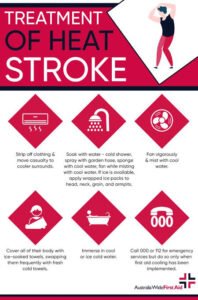
If someone is suspected of heat stroke it is necessary to treat them as early as possible to prevent maximum damage.
Here are some measures you can take to treat the condition:
- Move the person to a cool place preferably indoor or under some shade.
- Remove excess clothing.
- Keep them under fan or AC
- Hydrate them with fluids and electrolytes if he is in a condition to swallow.
- Seek medical attention if the condition is out of hand.
CONCLUSION:
Due to increase in climatic changes and global warming Heat Stroke has become one of the major concerns. As it is a life threatening condition so it is essential to take proper measures to prevent it. It is necessary to stay cool, hydrated and stay indoors when the weather conditions are not right.


